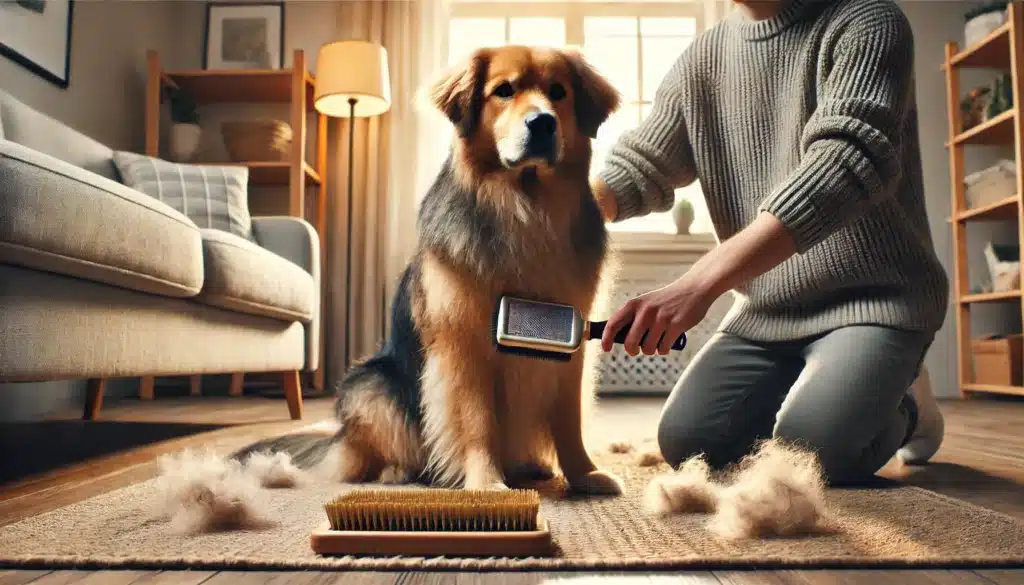Regular brushing is one of the most important habits any dog owner can develop — and yet, it’s one of the most underestimated. Whether your dog is long-haired, short-haired, curly-coated, or somewhere in between, brushing has powerful benefits that go far beyond appearance.
In this article, you’ll discover how often to brush based on breed and coat type, the benefits of brushing, how to choose the right brush, and pro tips to make grooming easier for both of you.
Why Brushing Your Dog Matters
Brushing does more than keep your dog looking neat. It plays a key role in:
- Removing loose hair: Minimizes shedding around the house
- Preventing mats and tangles: Especially in long-haired breeds
- Distributing natural oils: Promotes a shiny, healthy coat
- Stimulating the skin: Encourages blood circulation
- Checking for issues: Like bumps, ticks, or skin conditions
- Bonding with your dog: Many dogs love the attention
Skipping regular brushing can lead to painful mats, skin irritation, and even infections.
How Often Should You Brush? (By Coat Type)
There’s no universal answer. The ideal frequency depends on your dog’s coat.
🧶 Short-Haired Dogs (e.g. Beagle, Boxer, Doberman)
- Frequency: 1–2 times per week
- Why: These dogs don’t tangle, but brushing helps remove loose fur and distribute oils
- Brush type: Rubber curry brush or bristle brush
🧤 Medium-Length Coats (e.g. Labrador Retriever, Golden Retriever)
- Frequency: 2–3 times per week
- Why: Helps prevent undercoat buildup and seasonal shedding
- Brush type: Slicker brush or undercoat rake during shedding season
🧵 Long-Haired Dogs (e.g. Collie, Afghan Hound)
- Frequency: Daily
- Why: Their coats tangle easily and require more attention
- Brush type: Pin brush and metal comb for deeper detangling
🌀 Curly or Wavy Coats (e.g. Poodle, Bichon Frisé)
- Frequency: At least 3–4 times a week (ideally daily)
- Why: These coats mat quickly and hold debris
- Brush type: Slicker brush and comb
🐾 Double-Coated Breeds (e.g. Husky, German Shepherd)
- Frequency: 2–4 times per week (daily during shedding season)
- Why: To manage thick undercoats and heavy shedding
- Brush type: Undercoat rake + slicker brush
Choosing the Right Brush
Picking the wrong brush can be ineffective — or worse, uncomfortable for your dog. Here’s a quick guide:
| Coat Type | Best Brush Type |
|---|---|
| Short, smooth | Rubber brush, bristle brush |
| Long, silky | Pin brush, metal comb |
| Thick undercoat | Undercoat rake, slicker brush |
| Curly/wavy | Slicker brush, comb |
| Wire-haired | Slicker or stripping comb |
You may need more than one brush if your dog has a complex coat or sheds heavily.
Signs You’re Not Brushing Enough
Even if your dog seems “fine,” brushing more often might be necessary if:
- You notice tangles forming quickly
- Your dog scratches frequently
- There are clumps of fur around the house
- Your dog resists brushing (pain could be involved)
- The coat looks dull or dirty soon after grooming
- You feel mats developing under the topcoat
The sooner you catch these signs, the easier it is to get your dog’s coat back in good condition.
Tips for Easy, Stress-Free Brushing
- Start early: Get puppies used to the brush while they’re young
- Use treats: Positive reinforcement builds trust
- Brush when calm: After playtime or meals, your dog is more relaxed
- Go slowly: Rushing can cause discomfort
- Talk softly: Your tone helps set the mood
- Check sensitive spots: Like behind the ears, belly, and tail base
If your dog hates brushing, try doing it in short, gentle sessions and gradually increase the time. Don’t force it — the goal is to make grooming a routine, not a battle.
Should You Brush During Shedding Season?
Absolutely — especially for double-coated dogs! Brushing removes the dead undercoat that would otherwise end up on your floors and furniture.
During spring and fall, use tools like undercoat rakes or deshedding brushes to help remove the bulk of shedding fur. Daily brushing during this time is ideal.
What About Professional Grooming?
Even with regular home brushing, some breeds benefit from occasional visits to a groomer. This is especially true for:
- Long-haired dogs that need trimming
- Dogs with thick mats
- Breeds that need coat shaping or stripping
- Owners who struggle to manage grooming at home
Groomers have the expertise and tools to handle tough tangles and leave your dog looking and feeling great.
Final Thoughts: Make Brushing a Habit, Not a Hassle
Brushing your dog’s fur doesn’t have to be a chore. With the right tools, a calm approach, and a bit of consistency, it becomes an opportunity to care for your dog’s health and deepen your connection with them.
Whether it’s part of your morning routine or an evening wind-down activity, a few minutes of brushing can go a long way in keeping your dog comfortable, clean, and happy — every single day.







